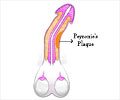A plastic surgeon is said to have helped a Muslim man whose failed circumcision left him with too little penile skin to perform his matrimonial duties, by using a technique to rehabilitate his penis.
A plastic surgeon is said to have helped a Muslim man whose failed circumcision left him with too little penile skin to perform his matrimonial duties, by using a technique to rehabilitate his penis.
Ibrahim, a 20-year-old Galilee Muslim, had his circumcision two years earlier, but because of the botched operation and his inability to function normally, his fiancee left him prior to their wedding.But plastic surgeon Prof. Yaron Har-Shai eventually enabled Ibrahim to get engaged to another woman by adapting - for the first time in the world - a technique used on hand and facial burns to rehabilitate his penis, restoring normal function.
Har-Shai and colleagues at Haifa's Carmel Medical Center and the Technion-Israel Institute of Technology's Rappaport Faculty of Medicine have just published their report on the highly unusual case in the British Journal of Plastic, Reconstructive and Aesthetic Surgery, which presents not only the details of the procedure but also 'before' and 'after' photos.
The doctors' careful search of the Medline database showed that the technique had not been used previously to correct such a problem.
The man, now 21, is due to wed a different woman who accepted his marriage proposal after hearing about the normal appearance and functioning of his penis.
Upon hearing the news, the Carmel staff who treated him sent the couple a huge bouquet of flowers and wishes for good luck and many children.
Instead of undergoing a ritual circumcision at the conventional age for Muslims - 13 years - the man waited until 18, apparently because he comes from a secular family and didn't think it was important, Har-Shai said.
The procedure was performed by an overzealous traditional practitioner, who botched the job. Instead of removing just the foreskin, he also cut off ventral penile skin, a complication that occurs in 0.2 percent of circumcisions.
Although able to have erections before the accident, the unfortunate man found that the error shortened his organ by causing the development of scar tissue that prevented the skin from expanding with increased blood supply.
Skin webbing developed from the sub-coronal groove to the anterior scrotal base. Intercourse was impossible, and when his first fiancee learned about his condition, the wedding was off.
An anaesthesiologist who knew the family turned to Har-Shai, a Technion graduate who worked at Haifa's Rambam Medical Center until he was invited to head the plastic surgery department at Carmel.
Surgeons abroad trying to treat similar injuries in the past took skin from other parts of the patient's body and transplanted it onto the penis; the result, however, was not only of a different colour but the penis also sometimes developed a web texture and became too small to allow for intercourse.
First, Har-Shai performed a known procedure called Z-plasty, a technique used to improve the functional and cosmetic appearance of scars. It can elongate a contracted scar or rotate the scar tension line. The procedure, however, was unsuccessful.
Har-Shai's father, Prof. Bernard Hirshowitz, was a pioneer in plastic surgery at Rambam before his retirement and years ago developed the "flap technique-5" procedure to enable webbed skin between fingers to become flexible after suffering a burn and shrinking, as well as for treating facial skin injuries. But it had never been used to rehabilitate a shrunken penis.
Har-Shai decided to adapt his father's innovation - for the first time in the world - to the young man's problem. He created five flaps from small bits of skin left on the man's penis itself so they were not rejected and did not turn into webbing.
"Although previous surgery had been executed at the surgical site, uneventful healing of the skin flaps and complete relaxation and elongation of the skin web [was] achieved," the Jerusalem Post quoted the team as writing.
The man's penile length measured 11 centimetres after the procedure - eight centimetres longer than it was after the complications from the circumcision set in. Two months after the operation, the patient had functional erections.
"It also looks great, very aesthetic," Har-Shai said.
He added that his father's flap technique-5 could also be used on baby boys if they have a shortage of skin.
There have been no previous reports of such a complication in circumcisions in Israel, even though some 50,000 ritual procedures are performed here each year.
Har-Shai said he saw references to the complication occurring in Iran.
"I would have no problem treating Iranians who need it," he added, though there are no diplomatic relations between the two countries.
Source-ANI
SRM













